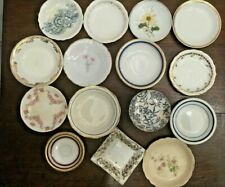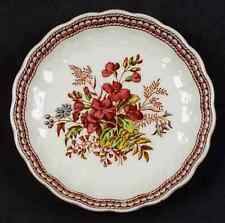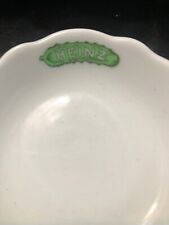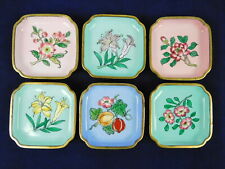
Awhile back I wrote a blog post on butter spreaders and butter knives. For some reason, when I wrote the article, I called the bread plate a butter plate. Thank goodness for the proofreader extraordinaire who caught my error.
That led to researching butter plates and their uses. These little plates, which are generally 3-4″ in diameter, are used to serve a pat of butter. Other names they go by are butter pat plates, butters, butter chips, and pads.

What makes them so difficult to distinguish is the size. After a bit of research, I realized that I actually own some butter pat plates, but did not realize what they were. Looking on eBay, many small plates are listed as coasters, butter pats, children’s doll plates, individual open salt plates, and individual ashtrays.
Apparently, butters were very popular during the Victorian era. Of course my mind wondered if there were equally tiny knives to get the pat off the plate, but so far I have not found any.

I have a small blue and white Delft plate which was a gift from someone who visited the factory. I believed it was a souvenir, but actually it could be a butter pat. I also have a few commemorative plates for various British royal occasions that may have been intended as butter pats. And I distinctly recall some small plates my mom owned, edged in a thick cobalt blue and thin gold line that had historical figures in the center. I am sure these were commemorative butter pats.
My eBay search also taught me that not too long ago butter pats were still being produced. I found a few butter pats to match my Spode Christmas Tree dishes. And there were a couple of my mom’s china patterns that had matching butter pats.

This post from 2017 probably contained a butter pat or two. The more recently produced butter pats seem to be for hotels and other forms of travel and transportation companies.
Even if you do not choose to use butter pats on your table, you may find the usefulness of the small sized plates to be indispensible. I keep any medicine/vitamins I am to take for the day on a butter pat. I also keep my rings on a butter pat. I recently discovered that a shower bomb fits perfectly in an old hotel dish I had, which is probably a butter pat. They are nice receptacles for tea bags, serving spoons, bon bons, and lemons. And of course, you could always use them for butter pats!


Thankyou for your artic le on butter pat plates. Do you know where to place it when setting a table? And do you think I I need a bread plate also?
Thanks for you assistance
Hi there! Your questions are great ones! The butter pat goes above the forks (so where we normally see a butter plate these days). As for butter pats and butter plates, I feel like you should do what makes the most sense for your situation (i.e. Do you have room for both?). However, if we were living in the Victorian or Edwardian eras, etiquette would dictate the answer, and if I had an etiquette book that old, surely it would say. The oldest etiquette books in my collection, that I can put my hands on right now, are from the 1940s-1960s. Three mention butter pats, but they do not give me a clear sense of whether a butter pat and/or butter plate would be used. Based on two books, I feel like it is an “or” situation. Social Usage: Second Edition and Emily Post’s Etiquette are the two books. The former states that if you aren’t using a bread plate, then you could use a butter pat. In the photos of the latter, it shows only a butter pat with butter knife, but no bread plate. It goes into more detail about formal dinners traditionally not serving butter nor having a bread plate on the table, that bread would be served on the warmed dinner plate (or could be placed on the table or tablecloth – no thank you!). It goes on to mention that these days (1940s) since people prefer butter to be served with their bread, one would not want to put butter on a warmed plate and have it melt. This discussion makes me think the butter pat may have been a way to keep butter off a warm plate at a formal dinner. The problem with my reasoning is that some of my old books state that formal dinners would not include butter on the table. Beeton’s Book of Household Management (1859-1861) refers to not serving butter on the table at certain meals, but I can’t find any place setting rules for butter pats and bread plates in that book. Since the historical etiquette of butter pats and plates is a bit murky, I think you can use both if space allows.
Hi,
I have about $150 china butterpat plates that I have collected for the past 50 yrs.
They are all different patterns, different colors, & different name brands.
I also have wooden frames that I had especially made to display them.
I hope you might be interested in buying them, or know somewhere that I might be able to sell them.
Thank you.
Jane, EBay, Marketplace or a consignment antique store near you are the best places I can think of. I don’t have place for another collection. I just have a few that fit in my China cabinet.
Good luck!